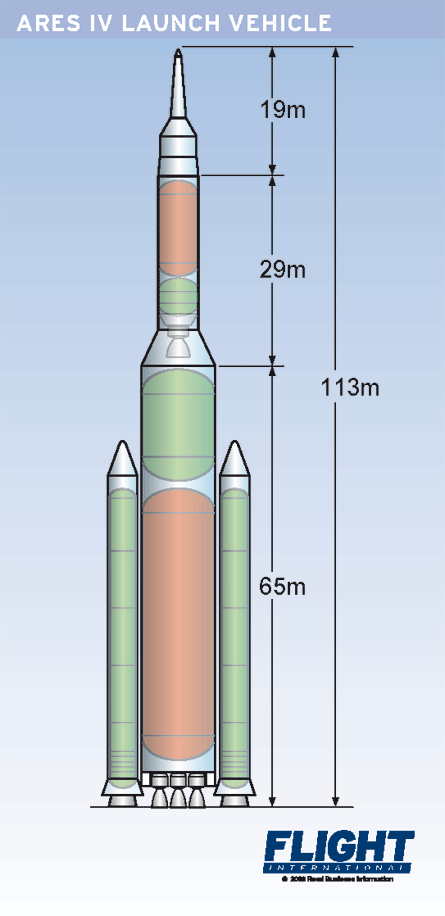Launch vehicle could send lunar lander direct to the Moon
NASA is budgeting for the development of a more powerful "Ares IV" crew launch vehicle (CLV) that could be test-flown in the second quarter of 2017, Flight International can exclusively reveal.
The proposed Ares IV would use the core stage from the Ares V heavylift launcher, two five-segment solid rocket boosters and the upper stage from the Ares I CLV to launch the Block 2 lunar mission Orion crew exploration vehicle. The 113m (367ft)-tall Ares IV would be capable of launching 41,100kg (90,420lb) to 240km (385 miles), with maximum g during ascent of 4.92 and core, upper stage separation at 327s, for direct trans-lunar injection.

The Ares IV, which is about 2.40m taller than the Apollo-era Saturn V, addresses the operational problem of Ares V's Earth departure stage (EDS), and its lunar lander, staying in low Earth orbit (LEO) for up to three months. This requirement, revealed in October on Flightglobal.com, adds mass and complexity to the EDS because of the need for long-term cryogenic propellant storage. That is necessary as under the Constellation architecture Ares V would be launched first and delays in sending the Ares I could see a period of weeks or even months before Orion docks with the EDS and its lunar module in preparation for trans-lunar injection from LEO.
"Ares IV is a study-level effort and not formally part of our baseline today. No definitive decisions have been made, and no specific requirements for such a mission defined. It will remain under study for the foreseeable future, but does represent an interesting capability," says NASA Constellation programme manager Jeffrey Hanley. While the programme has examined many launcher options, only the Ares IV is included in budgets along with the approved Ares I and V.
The new booster could eliminate the Ares V and its EDS. Instead a second Ares IV launch would send the lunar lander, possibly named Artemis, directly to the Moon. After two Ares IV launches, one for Orion and one for Artemis, the vehicles would rendezvous and dock in lunar orbit. In the Apollo programme the crew and service module spacecraft docked with the lunar module in Earth orbit.
If the Ares I was unable to launch the Block 1 Orion International Space Station mission variant, an Ares IV without its SRBs could be used. But NASA has denied that Ares I is not powerful enough to launch the Block 1 and 2 variants despite Orion project manager Caris Hatfield admitting that Orion is about 1,300kg over weight.
Constellation programme budget information and Ares IV schematics have been passed to Flight International following disquiet over the transparency of presentations at the NASA/American Institute of Aeronautics and Astronautics' second space exploration conference in Houston in December.
Source: Flight International



















